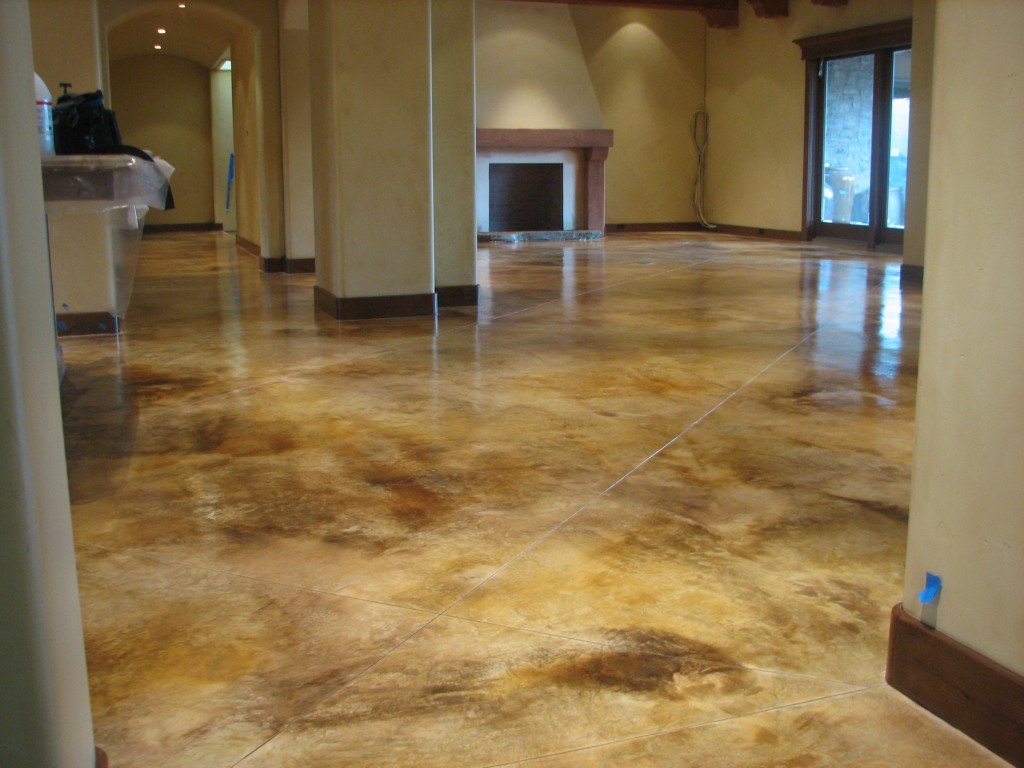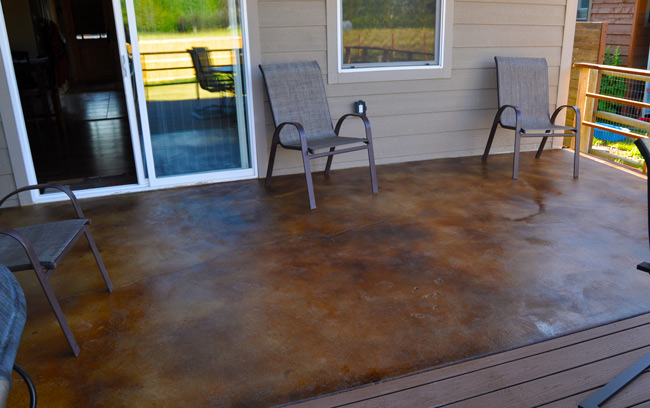Comprehending the Various Kinds Of Stained Concrete for Your Next Job
Stained concrete deals different options that deal with various aesthetic and functional requirements. Each type presents distinct features that affect the last look and toughness of the surface. Understanding these differences is key for any person intending a job. From rich, chemical reactions of acid-based stains to the lively uniformity of solid shade stains, the choices can considerably influence the outcome. What factors should one think about when picking the suitable tarnish for their specific requirements?
Review of Stained Concrete
Stained concrete works as a versatile floor covering choice that can boost the visual allure of various rooms. This strategy includes applying a tinting representative to the surface of existing concrete, permitting for a wide range of style opportunities. Stained concrete is preferred in both household and industrial settings, using a sturdy and low-maintenance option that can resemble the appearance of natural products like stone or tile.
The staining procedure can be performed making use of water-based or solvent-based items, each supplying distinct visual impacts. The final appearance is affected by variables such as the original concrete surface area, the sort of discolor utilized, and the application method. Stained concrete not just beautifies interiors and outsides however additionally promotes sustainability by revitalizing existing concrete structures. Therefore, it has gained traction among home owners and developers seeking both functionality and style in their floor covering selections.
Acid-Based Stains: Attributes and Advantages

Special Shade Variants
Concrete surfaces can change significantly with the application of acid-based stains, which offer a rich scheme of special shade variants. These stains pass through the concrete, reacting chemically to create vivid planet tones that range from deep browns and reds to soft environment-friendlies and blues. The resulting shades are typically variegated, developing a natural, marble-like look that boosts the concrete's character. Each application returns distinct results as a result of variations in the concrete's composition and the staining technique utilized, making every project unique. In addition, acid-based stains can be layered or incorporated with various other methods to create tailored designs, enabling personal expression. This flexibility makes acid-based stains a preferred selection for both residential and commercial applications.
Chemical Reactions Explained
While numerous elements contribute to the effectiveness of acid-based stains, the underlying chain reaction play an essential function in their one-of-a-kind characteristics and benefits. These stains mostly include water, acid, and metallic salts. When put on concrete, the acid reacts with the calcium hydroxide in the cement, creating a chemical improvement that leads to irreversible shade adjustments. The metal salts penetrate the surface and bond with the concrete, permitting a large range of shades and tones. This response not only enhances visual allure yet also offers longevity, making the color resistant to fading and wear. Additionally, acid-based stains can create a variegated coating that imitates natural stone, more boosting their popularity for ornamental concrete applications.
Surface Area Preparation Importance
Accomplishing perfect outcomes with acid-based stains hinges on detailed surface prep work. This necessary step guarantees that the concrete surface is clean, cost-free of impurities, and correctly profiled for perfect stain absorption. Any kind of existing sealers, dirt, or oils can prevent the chain reaction that creates the desired color and coating, causing uneven or irregular outcomes.
Before applying the discolor, the concrete ought to be mechanically cleaned up or pressure cleaned, adhered to by a complete inspection for fractures or flaws that may call for repair work. In addition, validating the surface area is adequately dried will improve tarnish adherence. By prioritizing these primary steps, the durability and vibrancy of acid-based stains can be substantially enhanced, causing a much more aesthetically pleasing and long lasting finish.
Water-Based Stains: Features and Benefits

Water-based stains permeate the concrete, using a much more transparent finish that highlights the natural appearance and variants of the surface beneath. They are available in a wide variety of colors, enabling creative flexibility in design. In addition, water-based stains are much easier to clean up, requiring only water and soap, which streamlines the application process.
Their quick drying time improves performance, making them a practical option for both DIY lovers and professionals. On the whole, water-based stains offer an appealing combination of aesthetic convenience and easy to use buildings, making them a prominent option for Learn More concrete improvement tasks.
Solid Shade Stains: Vibrant Alternatives for a Vibrant Look
Strong color stains offer an efficient solution for those seeking to create a vibrant and vibrant aesthetic on concrete surfaces. These stains supply a consistent pigmentation that can dramatically improve the aesthetic allure of floors, patios, and driveways. Offered in a wide range of colors, solid color stains enable imaginative expression, accommodating different design preferences.
Among the vital benefits of solid shade stains is their capacity to hide flaws, supplying a fresh and sleek want to maturing concrete - Stained Concrete Austin. Furthermore, their formula typically consists of UV-resistant residential properties, guaranteeing long life and shade retention also in severe climate condition
Application is simple, requiring marginal preparation of the concrete surface. Once applied, solid shade stains can be sealed for added protection and sheen, additional elevating their visual quality. With their lively choices, strong color stains are an exceptional selection for those aiming for an impactful and cohesive design.
Semi-Transparent Stains: Attaining Deepness and Dimension
Semi-transparent stains use an unique approach to enhancing concrete surfaces by supplying deepness and dimension with various color options. Understanding the application methods is crucial for accomplishing the desired effect, while appropriate maintenance practices ensure longevity. This section will discover these key facets to maximize the advantages of semi-transparent staining.
Shade Options Available
A variety of shade alternatives exists for semi-transparent stains, permitting homeowners and designers to enhance the all-natural beauty of concrete surfaces. These stains can be found in a range of tones, from natural tones like browns and terracottas to lively shades such as blues and eco-friendlies. The semi-transparent nature of these stains enables the underlying concrete to show with, creating a special deepness and measurement that can match numerous layout aesthetic appeals. Additionally, integrating various colors can create personalized shades, enabling a tailored try to find each project. This adaptability makes semi-transparent stains a prominent selection for both indoor and outside applications, as they can integrate with surrounding components while adding visual interest to ordinary concrete.
Application Strategies Explained
To achieve the preferred depth and dimension with semi-transparent stains, proper application methods are vital. First, surface preparation is important; the concrete has to be tidy and free of any type of pollutants. This typically includes power cleaning and fixing any kind of splits. Next off, picking the right applicator, such as a sprayer, roller, or brush, can affect the final appearance. Sprayers permit a more also application, while rollers can assist accomplish structure. It is very important to apply the stain in thin, even coats, permitting each layer to completely dry before adding another. Manipulating the application method, such as differing pressure or using different tools, can create one-of-a-kind impacts. Sealing the stained surface enhances the vibrancy of the shades while offering security.
Upkeep Ideal Practices
Routine maintenance is essential for preserving the elegance and integrity of surfaces treated with semi-transparent stains. To keep these surface areas, regular cleaning is important. Making use of a pH-neutral cleaner look at this now and a soft-bristle mop will certainly help eliminate dirt and debris without damaging the tarnish. It is suggested to avoid harsh chemicals, as they can deteriorate the discolor's appearance. Furthermore, periodic resealing each to three years can protect versus wear and fading. This procedure includes cleaning up the surface completely and using a suitable sealer developed for stained concrete. Homeowners must likewise keep track of for any type of indications of staining or damages and address these problems promptly to ensure long-lasting vibrancy and longevity. Following these best practices will certainly enhance the general lifespan of semi-transparent stained surface areas.
Effects and Methods: Personalizing Your Stained Concrete
Tailoring stained concrete involves a variety of strategies that enhance both looks and performance. Amongst these techniques, layering different stain colors can develop depth and intricacy, permitting special visual impacts. Methods such as acid staining give a variegated appearance, while water-based stains offer a more uniform appearance.
Furthermore, including attractive patterns, such as stenciling or engraving, can better customize the surface area, adding detailed layouts that cater to individual tastes. Texturing the concrete, whether through marking or broom finishes, presents tactile aspects that not only enhance grip but also enhance visual interest.
Applying sealers can magnify the shade vibrancy and supply protection against wear. Customization strategies extend beyond plain color; they can transform click for more a typical concrete piece into a magnificent focal factor, making it suitable for both household and commercial spaces. With careful choice of effects and methods, stained concrete can achieve a genuinely customized look.
Upkeep and Long Life of Stained Surfaces
Although stained concrete surface areas are understood for their resilience and visual appeal, keeping their stability is crucial for making certain long life. Regular cleansing is essential; sweeping and mopping with a pH-neutral cleaner assists avoid dust accumulation and staining. Additionally, applying a sealer every few years can secure the surface from wetness, chemicals, and UV damage, consequently enhancing its life expectancy.
It is additionally crucial to deal with any type of cracks or chips quickly. Small fixings can minimize additional wear and tear, protecting the visual and structural high quality of the surface. For outdoor stained concrete, seasonal maintenance, such as eliminating snow and ice, is required to avoid surface area damages from freeze-thaw cycles.
Often Asked Concerns
Can I Stain Existing Concrete Surfaces or Brand-new Ones?
The concern of whether existing concrete surfaces can be stained occurs often. It is without a doubt possible to discolor both new and old concrete, supplied the surface is effectively ready and free of contaminants for excellent attachment.
Exactly how Long Does the Staining Refine Generally Take?
The staining process commonly takes one to 3 days, depending on aspects such as surface area preparation, kind of tarnish, and weather condition conditions. Stained Concrete Floors Austin. Healing time may prolong beyond first application, affecting the general duration considerably
Is Stained Concrete Safe for Outdoor Use?
Stained concrete is usually safe for exterior use, offered it is properly sealed. This sealing protects against wetness and UV damages, ensuring durability and safety, while also boosting the aesthetic allure of outside areas.
Can I Apply Numerous Spot Layers for Various Impacts?
Using several discolor layers can attain varied effects on stained concrete. It is essential to ensure compatibility between stains and enable appropriate drying out time between applications to avoid unplanned reactions or staining.
Are There Any Type Of Shade Limitations for Stained Concrete?
Color limitations for stained concrete largely rely on the kind of discolor utilized, with water-based stains providing a more comprehensive scheme contrasted to acid-based stains. Stained Concrete Austin. Nevertheless, attaining vivid colors may need mindful choice and application methods